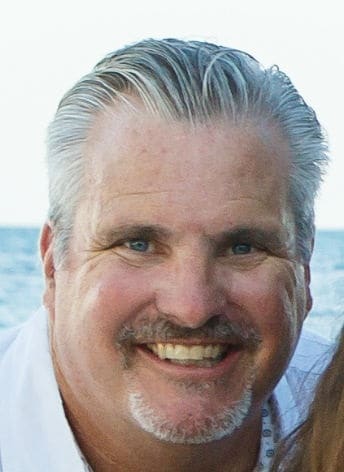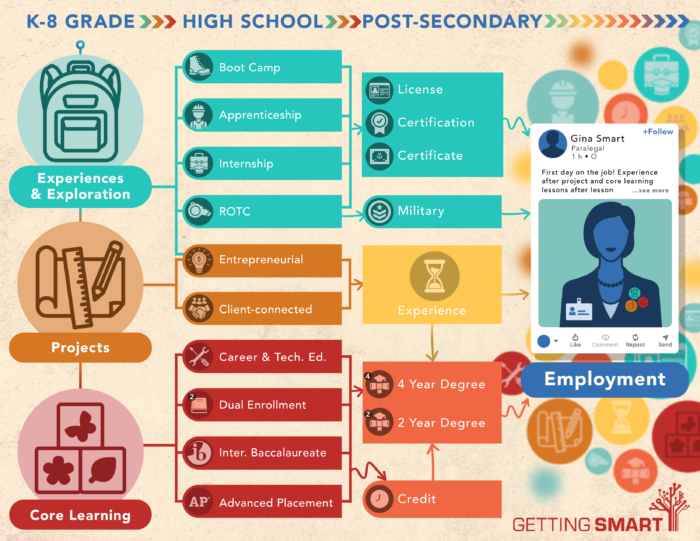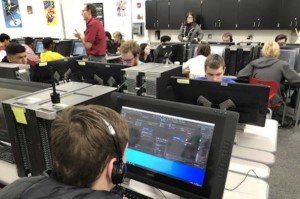7 Real-World Issues That Can Allow Students To Tackle Big Challenges

Ever since I started teaching in 1990, I have been a student voice advocate. Whether it was as a media/English teacher, student leadership advisor or a site leader. I have always believed that students not only have good ideas, but that they may just have new, unique or even better ones. In an effort to find their own voice and place in the world, they may see things that we don’t see or have long been paralyzed to do anything about. In 1999, I saw students address a school’s racial divide and cultural issues by creating a school-wide learning experience (see Harmony at Buchanan High School). Ever since then, I have believed that projects with real-world outcomes hold some of the greatest potential for helping students become driven, empathetic and engaged citizens. The outpouring of student voice in the wake of the recent tragedy in Parkland, Florida, is a great example.
When we begin the project design process in PBL, we can start either with a challenging problem or question and then tie it to our standards, or we can start with our standards and connect them to a real-world challenge. This second approach is more foundational to project based learning, for many reasons, including student engagement, student voice, relevance and authenticity. But beyond that, we also do it because this is where jobs are. Jobs are created and grown as we work to address the real problems facing our world and peoples. Our students are ready to tackle the problems facing our world. They have a voice. They have the tools and resources. And they are not afraid to collaborate and form new communities poised for the problem-solving work that needs to be done.
As an educator, parent and advocate for an engaged/empowered citizenry, I could not be prouder of how the students in Parkland, Florida – along with their peers across the nation – have both found their voice, as well as changed the narrative. These students, as well as many others across the nation, are not afraid to collaborate, and use new technologies and form new professional networks in order to address our current and future challenges. Let’s be honest, our best hope of improving the status of our planet’s many issues truly lie with our youth.
With all of this in mind, there are a number of current and ongoing real-world challenges that we currently face (and probably will for a long time). I don’t like the term “problem-solving” in this context, as it implies that we can fix, cure or eradicate a problem or challenge, but by going after our problems with new solutions, we can certainly move progress forward. And in that movement, there is magic. There is innovation. There is change. There is our collective human mission: how can we creatively collaborate, critically think and communicate in ways that make our world a better place to live.
Our students are ready to exercise their collective voices and create calls to action. The following seven ideas are not ranked, but are rather my go to “top seven” that naturally lend themselves to projects that excite student interest, rely on available resources, and maintain relevance and authenticity. Moreover, they are not subject-specific. Indeed, there are many opportunities for English, science, social science, math and others to connect to these project challenges. They are:
1) Climate Change – Climate Change will have a significant impact on our students’ lives. Indeed, there may not be one issue that will impact them more comprehensively. Students have seen the data and witnessed the changes, and are listening to the science community. They know that this an urgent issue that will affect almost everything, including, but not limited to, weather, sea levels, food security, water quality, air quality, sustainability and much more. Many organizations – such as NASA, The National Park Service, National Center for Science Education, National Oceanic Atmospheric Association and SOCAN to name a few – are working to bring climate change curriculum and projects to teachers and students.
2) Health Care – Since this has become a prominent topic in the national debate, students are becoming aware of the issues in our country related to rising costs, access, quality and equity. They are beginning to understand the importance both individually and societally. Like the aforementioned topic of climate change, students are also (and unfortunately) learning that we are not necessarily leading the world in this area. They know that this problem is connected to profits, insurance, bureaucracy and more, but they also have a fresher sense of how it could be different, and how we could learn from others around the world. The work on this topic, like many others, is being led by our universities. Institutions such as University of Michigan, Johns Hopkins and Stanford are leading the way.
3) Food Insecurity – as our students become more aware of their surrounding communities, as well as the peers they interact with daily, they begin to see differences. Differences in socioeconomic status, opportunities for growth, housing, security, support services and more. And since 13 million young people live in food-insecure homes, almost all of our students, as well as educators, know someone who is hungry on a daily basis. This may often start with service-based projects, but can also lead to high quality project based learning complete with research, data analysis, diverse solutions and ultimately a variety of calls to action. If you want to see how one teacher and his students transformed not only their school, but entire community related to food insecurity, check out Power Of A Plant author Stephen Ritz and the Green Bronx Machine.
4) Violence – This is a natural given current events taking the nation by storm. However, the related topics and issues here are not new. And yes, they are politically charged, but young people care about these issues. They care about their collective safety and futures, but also know something can be done. In addition to the specifics related to school violence and safety, students can study details of how to advocate, organize, campaign and solicit support, learn that this is a complex problem that has many plausible causes, and, perhaps most importantly, hope for progress. They also know that although they are concerned about attending school in safe environments, our society and culture have violence-related problems and issues that they want to see addressed. Following the recent incident in Florida and the subsequent response from students, the New York Times has compiled a list of resources for educators on this topic.
5) Homelessness – We often hear the expression “think globally, act locally.” The topic of homelessness has garnered more attention than ever as more and more communities wrestle with a growing homeless population. In addition to opportunities for our students and schools to partner with local non-profit organizations dealing with homelessness, this topic, like others, is also a great way to elicit empathy in our students. We often hear from educators, employers and others that we want to raise adults that are able to solve problems, improve our communities, and have the ability to see beyond themselves. This topic can provide a number of options for helping students develop those skills. Finally, we also have a growing population of homeless students. So, the relevancy and urgency are all there. Many have laid the groundwork for us to address this within our curriculum. Organizations like Bridge Communities, National Coalition For The Homeless, Homeless Hub and Learning To Give are some of the many leading the way.
6) Sustainability – This is an extremely global issue that affects everything from energy, to food, to resources, economics, health, wellness and more. Students are becoming more and more aware that our very future as a species depends on how we address sustainability challenges. They are aware that this challenge requires new ways of thinking, new priorities, new standards and new ways of doing things. Sustainability is all about future innovation. Students have tremendous opportunities to collaborate, think critically, communicate, and be creative when questioning if a current practice, method, resource or even industry is sustainable without dramatic change and shifts. Students who tackle these challenges will be our leaders – business, political and cultural – of the future. Educators and students can find almost infinite resources and partners. A few of these are Green Education Foundation, Green Schools Initiative, Strategic Energy Innovations, Facing the Future and Teach For America.
7) Education – It seems that each and every day, more and more of us (though maybe still not enough) are moving closer to realizing that our educational systems are seemingly unprepared to make the big shifts needed to truly address the learning needs of 21st-century students. The related challenges are many – new literacies, skills, economic demands, brain research, technology, outcomes and methodologies. It’s a good thing that more and more people – both inside and outside of education – are both demanding and implementing change. However, one of the continued ironies within education is that we (and I recognize that this is a generalization) rarely ask the primary customer (students) what they think their education should look, feel and sound like. We have traditionally underestimated their ability to articulate what they need and what would benefit them for their individual and collective futures. One of the many foundational advantages of project based learning is that we consult and consider the student in project design and implementation. Student “voice & choice” creates opportunities for students to have input on and make decisions regarding everything from the final product, to focus area within a topic or challenge, and even whom they may partner with from peers to professionals. It’s this choice that not only helps elicit engagement and ownership of learning, but offers opportunities for students to enhance all of the skills that we want in our ideal graduates. As one might guess, there is not a lot of formal curriculum being developed for teachers to lead students through the issue of education reform. This may need to be an organic thing that happens class by class and school by school. It can start as easily as one teacher asking students about what they want out of their education. Some other entry points are The Buck Institute for Education, Edutopia’s Five Ways To Give Your Students More Voice & Choice, Barbara Bray’s Rethinking Learning and reDesign.
This is not intended to be an exhaustive or comprehensive list. However, these seven broad topics present hundreds of relevant challenges that our students can and should have opportunities to address. If they do, they will not only be more prepared for their futures, but also poised to positively impact all of our futures.
For more, see:
- High Quality PBL Case Study: School21
- In Broward County, Student Voice Impacts the Classroom and Beyond
- Introducing a Framework for High Quality Project Based Learning
Stay in-the-know with all things EdTech and innovations in learning by signing up to receive our weekly newsletter, Smart Update.








Emmanuel BASWA
I found It more interesting, and I've learnt some thing new.
Kids Castle
Inspiring and practical, these real-world projects truly empower students to think critically and solve meaningful problems. Love the focus on creativity, collaboration, and impact. Thank you for sharing these cool ideas.